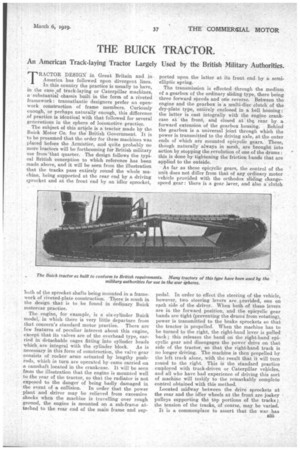THE BUICK TRACTOR.
Page 15

Page 16

If you've noticed an error in this article please click here to report it so we can fix it.
An American Track-laying Tractor Largely Used by the British Military Authorities.
TRACTOR DESIGN' in Great Britain. and in. America has followed upon divergent lines. In this country the practice is usually to have, in the ease of track-laying or Caterpillar machines, a substantial chassis built in the form of a riveted framework: transatlantic designers prefer an openwork construction of frame members. Curiously enough, or perhaps naturally enough, this difference .of practice is identical with that followed for several generations in the sphere of locomotive practice. The subject of this article is a tractor made by the Buick Motor Co. for the British Government. It is to be presumed that the order for these machines was placed before the Armistice, and quite probably no more tractors will be forthcoming for British military use from 'that quarter. The design follows the typical British conception to which reference has been made above, and it will be seen from the illustration that the tracks pass entirely round the whole machine, being supported at the rear end by a driving sprocket and at the front end by an idler sprocket, both of the sprocket shafts being mounted in a framework of riveted-plate construction. .There is much in the design that is to be found in ordinary Buick motorcar practice.
The engine, for example, is a six-cylinder Buick model, in which .there is very little departure from that concern's standard motor practice. There are few features of peculiar interest about this engine, except that its valves are of the overhead type, carried in detachable cages fitting into cylinder heads which are integral with the cylinder block. As is necessary in this form of construction, the valve gear consists of rocker arms actuated by lengthy pushrods, which in turn are operated by cams carried on. a camshaft located in the crankcase. It will be seen . fawn the illustration that the engine is mounted well to the rear of the tractor, so that the radiator is not exposed to the danger of being badly damaged in the event of a collision. In order that the power plant and driver may be relieved from excessive shocks when the machine is travelling over rough ground, the engine is mounted on a sub-frame attached to the rear end of the main frame and sup ported upon the latter at its front end by a semielliptic spring.
The transmission is effected through the medium of a gearbox of the ordinary sliding type, there being three forward speeds and one reverse. Between the engine and the gearbox is a multi-disc Clutch of the dry-plate type, entirely enclosed in a bell housing: the latter is cast integrally with the engine crankcase at the front, and closed at the rear by a forward extension of the gearbox housing. Behind the gearbox is a universal joint through which the power is transmitted to the driving axle, at the outer ends of which are mounted epicyclie gears. These, though naturally always in mesh, are brought into action by stopping the revolution of one of the drums : this is done by tightening the friction bands that are applied to the outside.
As far as these epicyclic gears, the control of the unit does not differ from that of any ordinary motor vehicle provided with the orthodox sliding changespeed gear : there is a gear lever, and also a clutch pedal. In order to effect the steering of the vehicle, however, two steering levers are provided, one on each side of the driver. When both of these levers are in the forward position, and the epicyclic gear bands are tight (preventing the drums from rotating), power is transmitted to the brake sprockets so that the tractor is propelled. When the machine has to be turned to the right, the right-hand lever is pulled back ; this releases the band on the right-hand epicyclic gear and disengages the power drive on that side of the tractor, so that the right-hand track is no longer driving. The machine is then propelled by the left track alone, with the result that it will turn round to the right. This is the standard practice employed with track-driven or Caterpillar vehicles, and all who have had experience of driving this sort of machine will testify to the remarkably complete control obtained with this method.
Located midway between the drive sprockets at the rear and the idler wheels at the front are jockey pulleys supporting the top portions of the tracks;' the tension of the tracks, of course, may be varied.
It is a commonplace to assert -that the war has
"demonstrated the suitability of motor lorries for the purposes of modern transport. It is no less true to assert that the track-laying or Caterpillar-type of vehicle has equally demonstrated that it can stand up successfully to heavy work over rough country or on unmetalled roads. Anyone faitiliar with the work done by vehicles of this type on the various Fronts in hauling heavy guns over soft ground, must recognize that a degree of mechanical development has
been attained, at which the Caterpillar-type of tractor becomes a 'commercial proposition. Although the military demand for machines of the type above described no longer exists, it Seems to us that there is a very great field for their commercial application, especially in the Colonies and elsewhere where roads are not developed to the tame degree that they are in England, and where sandy tracks and the like render other types of motor transport impossible.






















